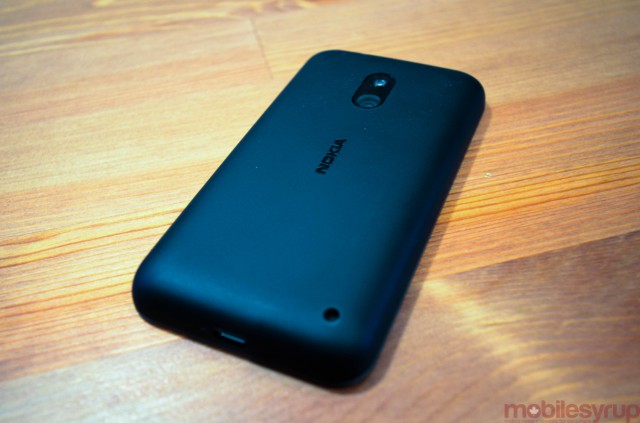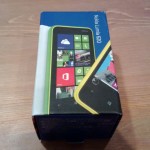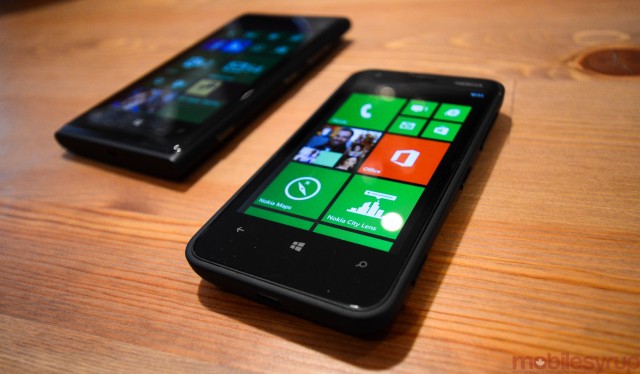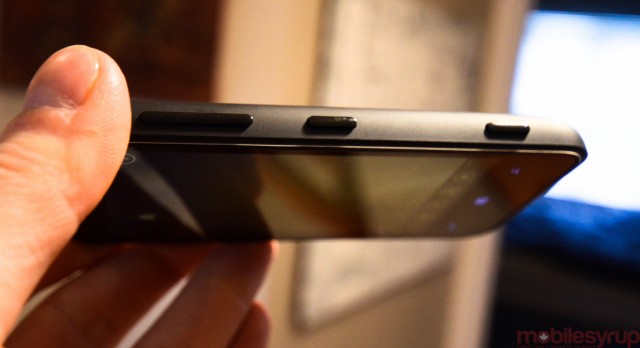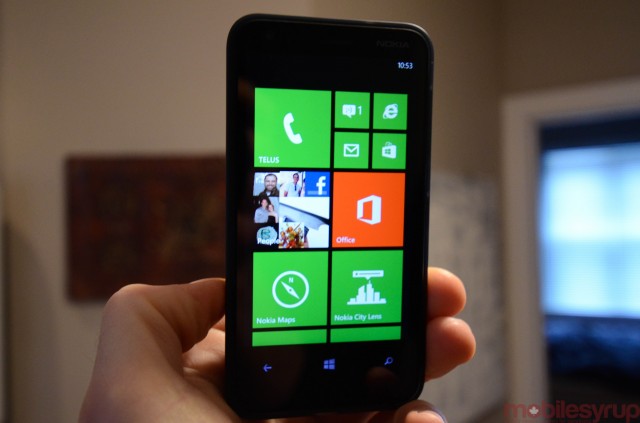
Nokia has a knack for releasing entry-level devices unmatched in build quality, price and software compatibility.
The Lumia 620 is a natural extension of its Windows Phone 7.5-based Lumia 610 predecessor, but accomplishes everything considerably faster. At $250 outright on TELUS and free on a two-year term, there aren’t many true competitors to the 620. But is it worth purchasing for the price alone, or are there better choices out there for the average smartphone buyer?
Specs
– Windows Phone 8 Portico release
– 3.8-inch 800x480px ClearBlack LCD
– 1Ghz dual-core Qualcomm Snapdragon S4 Plus SoC
– 512MB RAM, 8GB internal storage (+microSD card slot)
– 5MP back camera, VGA front camera
– 1300mAh removable battery
– WiFi (b/g/n), Bluetooth 3.0, NFC, A-GPS
– HSPA+ 21Mbps/5.76Mbps
– 115 x 61 x 11mm
– 127g
What’s Good
There may not be a lot to say about the Lumia 620 past the obvious: it’s a wonderful device at any price, but particularly at $250.
The screen is sharp, with excellent colour saturation and lovely contrast levels; viewing angles are fine, though anything past 30 degrees horizontal gets washed out. The ClearBlack display is responsive and gloriously one hand-friendly. There’s something peaceful about using a device this size after handling larger Android devices for the past year. Even the Lumia 920 feels cumbersome at times, and in using the 3.8-inch Lumia 620 it made me long for a simpler time.
More practically, though, the smaller screen means one-handed typing is a pleasure, as is the ability to reach any spot on the screen without adjusting the phone in your hand. Similarly, tipping the phone to one side to use as a camera is a subtle affair, and the 11mm thickness is negated by the phone’s trivial 127g weight.
Windows Phone 8 has really come a long way since its launch, with a bevy of well-made, nicely-designed, high performance apps available on the Windows Store. The Lumia 620 benefits from all of them, and runs the majority of apps with a consistency that most entry-level Android devices couldn’t dream of. Nokia didn’t skimp on power in this handset: a dual-core Snapdragon processor is plenty fast to run the latest apps and games, barring a few graphically-intense 3D ones like Asphalt 7.
The camera is quite good for a 5MP shooter, with a quick shutter and powerful flash. It in no way captures photos that compare to the excellent image-stabilized results of the Lumia 920, but Nokia does right by this little camera phone. Similarly, the Finnish OEM saw fit to include a front-facing shooter, albeit at a paltry VGA resolution, but the same can’t be said for the HTC 8S.
And while the Lumia 620 won’t win any awards for design, it does come with a removable back cover whose matte black finish can be replaced with a variety of hues. Battery life from the 1300mAh cell was excellent — we obtained longer than a day per charge — and call quality was similarly good. The device also has a microSD slot to expand storage another 64GB, if desired.
- Excellent outright price
- Fantastic one-handed usage
- Able to keep up with its more expensive peers in terms of performance
- Good call quality and battery life
- Nice screen
- Replaceable back cover
- microSD slot
What Needs Work
The Lumia 620, while great value, is only such when purchasing outright; far better phones can be had for $0, though you may have to sign a three-year contract (as opposed to a two-year) for the privilege. It may also be worth waiting to see if a Canadian carrier will release the newly-announced Lumia 720, which may carry a bit more bang for the buck.
If there is one serious design flaw in the Lumia 620, it’s that in removing and replacing the back cover, a non-trivial amount of pressure is exerted on the thin glass screen. This leaves the phone open to user-generated cracks, something that would have been avoided with a different mechanism.
The screen on the Lumia 620 also displays a fair amount of ghosting, a result of latency from a relatively cheap LCD part. Similarly, while the camera quality may be good enough for an entry-level device, it’s certainly not up to par with most mainstream handsets for a couple hundred dollars more. Lack of LTE connectivity will also be a concern for some users, especially as this is launching on TELUS and not Koodo.

Other than those minor quibbles, there really isn’t much to complain about here. We could continue to drive home the idea that Windows Phone lacks many of the top apps users can take advantage of on iOS or Android, namely Instagram, Flipboard, Path and more, but the OS itself integrates many of those popular functions. Facebook and Twitter integration is excellent, and developers are slowly coming around to the platform.
- Back cover removal is poorly designed
- Lacks LTE capabilities
- Can’t play some more graphically-intensive games
- Screen shows some ghosting
- Competitively priced only when purchased outright
- Windows Phone 8 still lacks many of the top apps available on iOS and Android
Final Words
The Nokia Lumia 620 is a competitively-priced entry-level smartphone and deserves a good look. It’s not necessarily the right choice for those signing a multi-year contract, since many better devices are discounted to $0 on three-year terms at the moment, but combined with an inexpensive pre- or post-paid plan, there aren’t many choices better than this.
Hitting all the right notes where it counts — performance, battery life, form factor — the Lumia 620 is let down only by the continued paucity of great Windows Phone 8 apps, though the number is certainly growing. Consider the Lumia 620 over the similarly-priced Windows Phone 8S, if only for the Lumia-exclusive app catalogue.
The Nokia Lumia 620 is available from TELUS for $250 outright.

